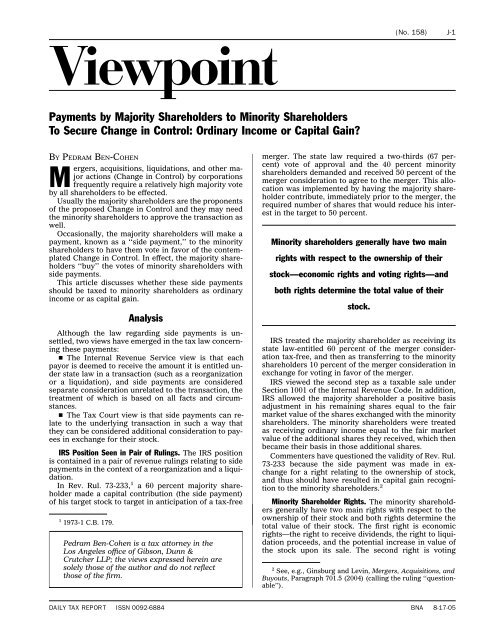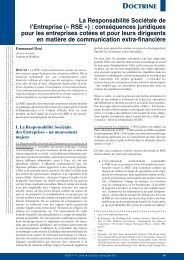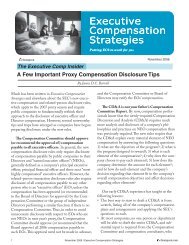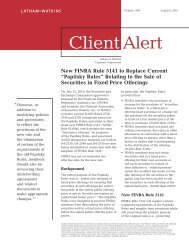XPP-PDF Support Utility
XPP-PDF Support Utility
XPP-PDF Support Utility
Create successful ePaper yourself
Turn your PDF publications into a flip-book with our unique Google optimized e-Paper software.
(No. 158) J-1<br />
Viewpoint<br />
Payments by Majority Shareholders to Minority Shareholders<br />
To Secure Change in Control: Ordinary Income or Capital Gain?<br />
BY PEDRAM BEN-COHEN<br />
Mergers, acquisitions, liquidations, and other major<br />
actions (Change in Control) by corporations<br />
frequently require a relatively high majority vote<br />
by all shareholders to be effected.<br />
Usually the majority shareholders are the proponents<br />
of the proposed Change in Control and they may need<br />
the minority shareholders to approve the transaction as<br />
well.<br />
Occasionally, the majority shareholders will make a<br />
payment, known as a ‘‘side payment,’’ to the minority<br />
shareholders to have them vote in favor of the contemplated<br />
Change in Control. In effect, the majority shareholders<br />
‘‘buy’’ the votes of minority shareholders with<br />
side payments.<br />
This article discusses whether these side payments<br />
should be taxed to minority shareholders as ordinary<br />
income or as capital gain.<br />
Analysis<br />
Although the law regarding side payments is unsettled,<br />
two views have emerged in the tax law concerning<br />
these payments:<br />
s The Internal Revenue Service view is that each<br />
payor is deemed to receive the amount it is entitled under<br />
state law in a transaction (such as a reorganization<br />
or a liquidation), and side payments are considered<br />
separate consideration unrelated to the transaction, the<br />
treatment of which is based on all facts and circumstances.<br />
s The Tax Court view is that side payments can relate<br />
to the underlying transaction in such a way that<br />
they can be considered additional consideration to payees<br />
in exchange for their stock.<br />
IRS Position Seen in Pair of Rulings. The IRS position<br />
is contained in a pair of revenue rulings relating to side<br />
payments in the context of a reorganization and a liquidation.<br />
In Rev. Rul. 73-233, 1 a 60 percent majority shareholder<br />
made a capital contribution (the side payment)<br />
of his target stock to target in anticipation of a tax-free<br />
1 1973-1 C.B. 179.<br />
Pedram Ben-Cohen is a tax attorney in the<br />
Los Angeles office of Gibson, Dunn &<br />
Crutcher LLP; the views expressed herein are<br />
solely those of the author and do not reflect<br />
those of the firm.<br />
merger. The state law required a two-thirds (67 percent)<br />
vote of approval and the 40 percent minority<br />
shareholders demanded and received 50 percent of the<br />
merger consideration to agree to the merger. This allocation<br />
was implemented by having the majority shareholder<br />
contribute, immediately prior to the merger, the<br />
required number of shares that would reduce his interest<br />
in the target to 50 percent.<br />
Minority shareholders generally have two main<br />
rights with respect to the ownership of their<br />
stock—economic rights and voting rights—and<br />
both rights determine the total value of their<br />
stock.<br />
IRS treated the majority shareholder as receiving its<br />
state law-entitled 60 percent of the merger consideration<br />
tax-free, and then as transferring to the minority<br />
shareholders 10 percent of the merger consideration in<br />
exchange for voting in favor of the merger.<br />
IRS viewed the second step as a taxable sale under<br />
Section 1001 of the Internal Revenue Code. In addition,<br />
IRS allowed the majority shareholder a positive basis<br />
adjustment in his remaining shares equal to the fair<br />
market value of the shares exchanged with the minority<br />
shareholders. The minority shareholders were treated<br />
as receiving ordinary income equal to the fair market<br />
value of the additional shares they received, which then<br />
became their basis in those additional shares.<br />
Commenters have questioned the validity of Rev. Rul.<br />
73-233 because the side payment was made in exchange<br />
for a right relating to the ownership of stock,<br />
and thus should have resulted in capital gain recognition<br />
to the minority shareholders. 2<br />
Minority Shareholder Rights. The minority shareholders<br />
generally have two main rights with respect to the<br />
ownership of their stock and both rights determine the<br />
total value of their stock. The first right is economic<br />
rights—the right to receive dividends, the right to liquidation<br />
proceeds, and the potential increase in value of<br />
the stock upon its sale. The second right is voting<br />
2 See, e.g., Ginsburg and Levin, Mergers, Acquisitions, and<br />
Buyouts, Paragraph 701.5 (2004) (calling the ruling ‘‘questionable’’).<br />
DAILY TAX REPORT ISSN 0092-6884 BNA 8-17-05
J-2 (No. 158) VIEWPOINT<br />
rights—the right to vote for major decisions of the corporation,<br />
vote for the board of directors, etc. 3<br />
Because the side payment was made with respect to<br />
one of the bundle of rights the minority shareholders<br />
had as owners of stock, they should have been entitled<br />
to capital gain treatment.<br />
Commenters have also questioned the ruling because<br />
it assumes that the majority shareholder’s interest in<br />
the Target was worth 60 percent of the merger consideration.<br />
But this assumption is contrary to the fact that<br />
the minority shareholders could block the majority<br />
shareholder from receiving 60 percent, at least in connection<br />
with a merger transaction. The majority shareholder<br />
could at best receive 50 percent, which should be<br />
its full value.<br />
The IRS position is also demonstrated in Rev. Rul. 79-<br />
10, 4 where it ruled that a non-pro rata liquidation<br />
should be treated as two separate transactions:<br />
s as a pro rata liquidation based on each shareholders<br />
entitled interest in the corporation’s assets giving<br />
rise to full payment in exchange for each shareholder’s<br />
stock, and<br />
s as a separate payment (the side payment) by the<br />
majority shareholder to the minority shareholders<br />
equal to the excess the minority shareholders received<br />
over their pro rata share.<br />
Facts and Circumstances Analysis. IRS stated that the<br />
characterization of the side payment would be determined<br />
by the underlying nature of the payment, which<br />
in turn depends on all relevant facts and circumstances.<br />
IRS’s facts and circumstances analysis stemmed from<br />
an internal memorandum where it instructed its agents<br />
to analyze the real reason for side payments and the<br />
true motivation of all parties in a transaction, which includes<br />
such payments. For example, side payments may<br />
be a gift, compensation for services, to protect a business’s<br />
reputation, in settlement of potential claims, etc. 5<br />
Rev. Rul. 79-10 is different from Rev. Rul. 73-233,<br />
however, because the majority shareholder in Rev. Rul.<br />
79-10 had the power under state law to effect the liquidation<br />
and could have received his pro rata share but<br />
decided not to ‘‘for various reasons.’’ In Rev. Rul. 73-<br />
233, IRS ruled that a side payment made in exchange<br />
for the minority shareholders cooperation with a<br />
merger was considered ordinary income. In Rev. Rul.<br />
79-10, IRS stated that the tax consequences to the minority<br />
shareholder would be based on the reason for the<br />
side payment in light of all facts and circumstances.<br />
Although this distinction exists, the rulings are still<br />
consistent with each other.<br />
3 See Rev. Rul 83-120, 1983-2 C.B. 170 (right to disapprove<br />
of a transaction is a component of stock valuation); Rev. Rul.<br />
81-282, 1981-2 C.B. 78 (‘‘right to vote is inherent in the ownership<br />
of common stock and, as such, is a property right’’).<br />
4 1979-1 C.B. 140.<br />
5 Gen. Couns. Mem. 37,649 (Aug. 25, 1978).<br />
6 43 B.T.A. 1185 (1941).<br />
Tax Court Reasoning. Unlike the position taken by<br />
IRS, the Tax Court has held that side payments are<br />
treated as additional consideration to payees in exchange<br />
for their stock because they stem from the underlying<br />
transaction.<br />
For example, in Delong v. Commissioner, 6 a majority<br />
shareholder paid the taxpayer, a minority shareholder,<br />
$14,000 ‘‘out of his own money’’ to secure his cooperation<br />
in a merger he was negotiating. A tax-free merger<br />
was effected and the taxpayer received stock of the acquiring<br />
company and $14,000 (the side payment).<br />
IRS argued that the side payment should be treated<br />
as ordinary income to the taxpayer because it was paid<br />
by the majority shareholder and not the acquirer, it was<br />
not part of the merger agreement, and none of the other<br />
shareholders of the target received a similar payment.<br />
The taxpayer, on the other hand, argued the side payment<br />
should be treated as additional consideration received<br />
as part of the merger.<br />
The Tax Court agreed with the taxpayer and held that<br />
the side payment plus the acquiring company stock was<br />
the total consideration received by the taxpayer in the<br />
merger. Additionally, the excess consideration over the<br />
taxpayer’s basis in the target shares was considered<br />
capital gain. But to the extent the taxpayer received the<br />
acquiring company’s stock based on a tax-free reorganization,<br />
that portion of the realized gain was not subject<br />
to capital gain recognition.<br />
The Tax Court explained its holding by stating,<br />
‘‘There is no requirement of which we have been made<br />
aware that the sales price of an article cannot be paid in<br />
whole or in part by one other than the vendee.’’ 7<br />
The commissioner acquiesced in this conclusion and<br />
has not withdrawn its acquiescence. 8<br />
Holding in ‘Gidwitz.’ Like its decision in Delong, the<br />
Tax Court in Gidwitz v. Commissioner, 9 held that a<br />
$225,000 payment (the side payment) received by a minority<br />
shareholder in settlement of a lawsuit based on a<br />
reorganization represented additional consideration received<br />
in the merger.<br />
The taxpayer was the minority shareholder who entered<br />
into an oral agreement with the majority shareholder.<br />
Similar to the IRS position in its internal memorandum<br />
discussed above, the Tax Court sought to find<br />
out the underlying reason for the side payment. The<br />
Tax Court found that the majority shareholder agreed<br />
to grant the taxpayer options to purchase certain real<br />
estate in exchange for the taxpayer agreeing to cooperate<br />
with a merger.<br />
After the merger was effected, the majority shareholder<br />
did not execute the options on behalf of the taxpayer<br />
and the taxpayer sued the majority shareholder.<br />
The lawsuit settled and the taxpayer received an additional<br />
$225,000.<br />
Similar to its position in Delong, IRS argued that the<br />
side payment should be taxed as ordinary income in<br />
consideration for the taxpayer agreeing not to vote<br />
against the merger.<br />
The Tax Court held that the side payment was additional<br />
consideration received by the taxpayer in exchange<br />
for its stock pursuant to the merger, and thus<br />
should be taxed as capital gain.<br />
Conclusion<br />
Assuming a side payment is made to a minority<br />
shareholder, upon a challenge by IRS the service would<br />
argue that the side payment is like the contribution of<br />
stock made by the majority shareholder in Rev. Rul. 73-<br />
7 Id. at 1187-1188.<br />
8 See 1941-1 C. B. 3.<br />
9 61 T.C. 664 (1974).<br />
8-17-05 COPYRIGHT 2005 BY THE BUREAU OF NATIONAL AFFAIRS, INC., WASHINGTON, D.C. DTR ISSN 0092-6884
VIEWPOINT (No. 158) J-3<br />
233. And thus, the tax consequences of that ruling<br />
should apply.<br />
Conversely, a minority shareholder would argue the<br />
payment he received was made with respect to his<br />
rights as a shareholder to transfer or sell his stock. So<br />
the side payment should be treated as additional consideration<br />
relating to the underlying Change in Control<br />
event, resulting in capital gain.<br />
While Delong was decided in 1941 and the rulings<br />
and Gidwitz were decided in the 1970s, a court should<br />
still take the position followed by the Tax Court. The<br />
reason is IRS acquiesced in the conclusion of Delong<br />
and has not withdrawn its acquiescence.<br />
Additionally, while Delong and Gidwitz represent<br />
cases decided by the Tax Court, the rulings only represent<br />
IRS’s interpretation of the tax law. 10 As a result,<br />
the tax consequences described in the cases have a<br />
higher chance of applying to a side payment than the<br />
rulings.<br />
Accordingly, side payments to minority shareholders<br />
should be taxed as capital gain.<br />
10 Treas. Reg. Section 601.201(a)(6) (Revenue rulings are<br />
an ‘‘official interpretation by the Service . . . and are published<br />
for the information and guidance of taxpayers’’).<br />
DAILY TAX REPORT ISSN 0092-6884 s BNA 8-17-05







